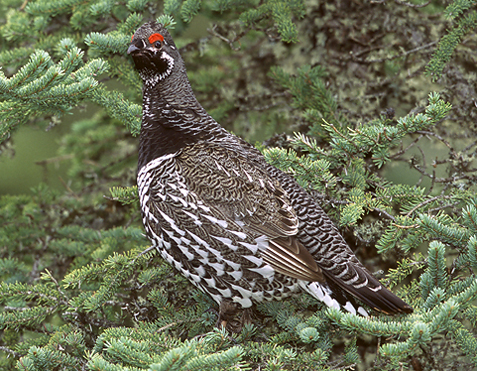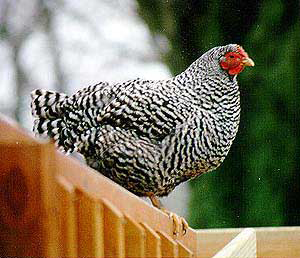What is most remarkable about Meriwether Lewis‘s work as a naturalist is that, considering how many other responsibilities he bore, he observed and wrote so much about the plants and animals he saw. When he had the leisure, as he did during the long wait on the west side of the Rockies in May and June 1806, he wrote in such detail. Indeed, it was only the division of his concentration, no doubt, that made some of his descriptions ambiguous, and occasionally erroneous. He was, nonetheless, persistent, objective, and thoughtful. Moreover, he could easily recognize new species by comparing virtually everything he saw with previous observations. An unusual example is his description of the bird now commonly known in the U.S. and Canada as the spruce grouse.
Lewis’s Description
The large black and white pheasant is peculiar to that portion of the Rocky Mountain watered by the Columbia river. at least we did not see them in these mountains until I we reached the waters of that river nor since we have left those mountains. they are about the size of a well grown hen. the contour of the bird is much that of the redish brown pheasant common to our country. the tail is proportionably as long and is composed of eighteen feathers of equal length, of an uniform dark brown tiped with black. the feathers of the body are of a dark brown black and white. the black is that which most predominates, and the wh[i]te feathers are irregularly intermixed with those of the black and dark brown on every part, but in greater proportion about the neck breast and belley. this mixture gives it very much the appearance of that kind of dunghill fowl[1]“Dunghill” was then the common designation for domestic, or “barnyard,” chickens, Gallus gallus, more formally classified as members of the biological order Galliformes. which the hen-wives of our country call domanicker.
in the brest of some of these birds the white predominates most. they are not furhished with tufts of long feathers on the neck as our pheasants are, but have a space on each side of the neck about 2½ inches long and 1 In. in width on which no feathers grow, tho’ tis concealed by the feathers which are inserted on the hinder and front part of the neck; this space seems to surve them to dilate or contract the feathers of the neck with more east. the eye is dark, the beak black, curved somewhat pointed and the upper exceeds the lower chap.[2]The chaps are the parts of the beak.
they have a narrow stripe of vermillion colour above each eye which consists of a fleshey substance not protuberant but uneven with a number of minute rounded dots. it has four toes on each foot of which three are in front. it is booted to the toes. it feeds on wild fruits, particularly the berry of the sac-a-commis, and much also on the seed of the pine and fir.—
The Corps might have been amused by this bird’s attitude. Whereas the blue grouse sets sail from the mountainside with a certain nonchalance, and the ruffed grouse explodes into the air with a sound that seems super-avian, the spruce grouse often poses on a log and stares–or glares–at the intruder as if reassured by profound faith in its camouflage
Taxonomic History
Although it normally outweighs a spruce grouse by as much as five or six pounds, one can see why Lewis thought of the Dominique chicken when he saw the spruce grouse. The Dominique was one of the most popular breeds of chickens in 18th- and early 19th-century America. It is sometimes confused with the Barred Plymouth Rock chicken. Lewis and Clark spelled the name as they heard most Americans pronounce it—”dominicker.”
Chickens were called “dunghill” or “barnyard” fowl because they fed partly on undigested seeds that they pecked from the dung of cows and horses.
Chicken-raising was strictly a woman’s responsibility in Lewis and Clark’s day, which accounts for the epithet “hen-wife.” Applied to a man, it was a term of contempt.
Lewis wrote his description at Fort Clatsop on March 3, 1806. In 1814, Nicholas Biddle paraphrased Lewis’s description as follows, and in 1893 the ornithologist Elliott Coues emended Biddle’s Lewis as noted (and bolded by the present editor) in the brackets:
The large black and white pheasant [adult male of Dendragapus franklini] differs but little from those of the United States; the brown is rather brighter and has a more reddish tint. This bird has 18 [usually 16]. . . feathers in the tail, of about six inches in length. He is also booted to the toes. The two tufts of long black feathers, [one] on each side of the neck, so common in the male of this species [meaning the ruffed grouse, Bonasa umbellus] inhabiting the United States, are no less [read, are not at all] observable in this pheasant. The feathers on the body aree of a dark brown, tipped with white and black, in which mixture the black predominates; the white [ones] are irregularly intermixed with those of the black and dark brown in every part, but in greater proportion about the neck, breast, and belly; this mixture makes this bird resemble much that kind of dunghill fowl which the housewives of our country call Domminicker [Dominique]. On the breast of some [specimens] of this species the white predominates. The [absences of] tufts on the neck leave a space about 2½ inches long and one inch in width [on each side], where no feathers grow, though concealed by the plumage connected with the higher and under [hind and front] parts of the neck; this space enables them to contract or dilate the feathers on the neck with more ease. The eye is dark; the beak is black, curved, somewhat pointed, and the upper exceeds the under chop; a narrow vermillion stripe tuns above each eye, not[very] protuberant, but uneven with a number of minute rounded dots [papillae]. This bird feeds on wild fruits, particularly the berry of the sacacommis, and exclusively resides in that portion of the Rocky mountains watered by the Columbia.
Lewis had added a paragraph on a “small speckled pheasant found in the same country with that above described,” which differed only in terms of size and “somewhat in colour.” Biddle included an edited version of it. Subsequently, ornithologists concluded that Lewis had mistaken a female of the same species for a variant of the preceding specimen.
The taxonomic history of this bird alone will serve to show how scientific insights have continually changed, as new analytical techniques and understandings have evolved. In 1895, today’s spruce grouse was called Canada grouse, Dendragapus canadensis (“tree-lover of Canada), and a similar bird was Franklin’s grouse (Dendragapus franklinii (“Franklin’s tree-lover”).[3]John Franklin (1786-1847) was an English sea-captain and arctic explorer who led an ill-fated expedition to the Northwest Territories in 1819-22 in search of a Northwest Passage between the Atlantic … Continue reading In 1910 it was called the Hudsonian spruce partridge, Canachites canadensis (“Canadian noisemaker”). In 1931 its accepted common name in the U.S. became spruce grouse, while its scientific name, as well as that of Franklin’s grouse, remained the same as in 1910. In 1957 the distinction between the spruce grouse and Franklin’s grouse was dissolved by ornithologists, and the spruce grouse became the sole representative of the genus, keeping the name Canachites canadensis. In 1983, the genus of the spruce grouse was changed to Dendragapus, the species remaining canadensis. Five years later the Latin binomial for the spruce grouse was changed to Falcipennis canadensis. (The genus Falcipennis evidently was introduced as early as 1864, but the meaning of the Latin word is obscure nowadays.) In the 1950s and 60s, grouse hunters in the Bitterroot Mountains still called them “Franks,” although few if any Nimrods knew who Frank was.
Notes
| ↑1 | “Dunghill” was then the common designation for domestic, or “barnyard,” chickens, Gallus gallus, more formally classified as members of the biological order Galliformes. |
|---|---|
| ↑2 | The chaps are the parts of the beak. |
| ↑3 | John Franklin (1786-1847) was an English sea-captain and arctic explorer who led an ill-fated expedition to the Northwest Territories in 1819-22 in search of a Northwest Passage between the Atlantic and Pacific Oceans via the Coppermine River. Eleven of his 22 men died–most of starvation, and one of murder. He made a second overland journey in 1825-27, reaching the Arctic Ocean. With the support of the British Admiralty, he undertook a third expedition in 1845, by ship. This was even more disastrous. Franklin and all 128 of his men died, probably of scurvey, and the remains of most were never found. The water route across the continent that heroes and nations had sought for centuries was finally found in 1906 by Roald Amundsen of Norway, but it proved no more “practicable” than Lewis and Clark’s had been. The first crossing in a single ship was made by a Royal Canadian Mounted Police schooner in 1944. Accompanying Franklin on his first two expeditions was the Scottish surgeon, naturalist, and arctic explorer, Sir John Richardson (1787-1865), who wrote sections on geology, botany, and icthyology for the official report. His numerous discoveries were recounted in two important books. One was Flora Boreali-Americana (Plants of North America, 1833-40), in collaboration with the English botanist William Jackson Hooker (1785-1865). It was Richardson who named a species of Dendragapus in honor of Franklin. His other book was the highly influential Fauna Boreali-Americana (Animals of North America, 1829-1837), in collaboration with the English ornithologist and artist William Swainson (1789-1855); the Keeper of Zoology at the British Museum in London, John Edward Gray (1800-1875); and the English entomologist William Kirby (1759-1850). |


